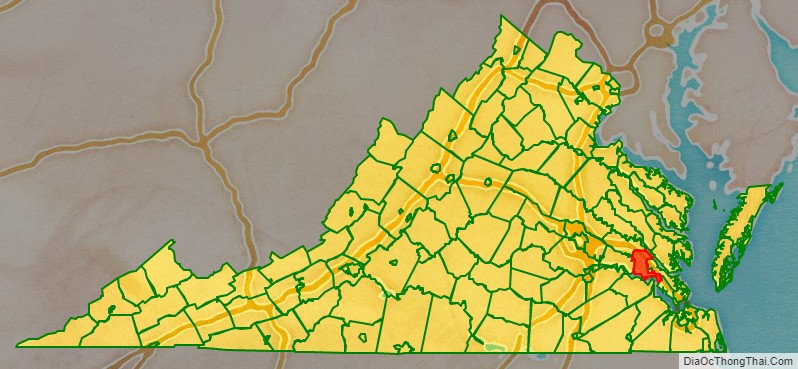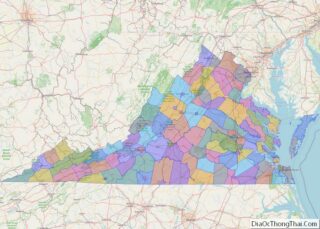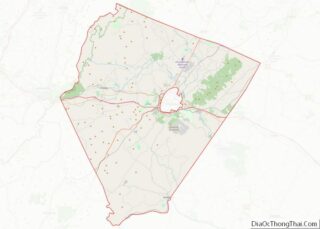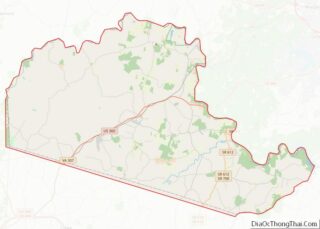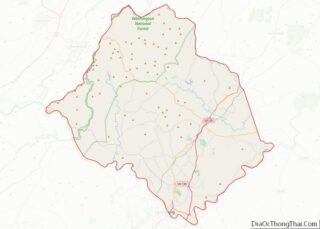James City County is a county located in the Commonwealth of Virginia. As of the 2020 census, the population was 78,254. Although politically separate from the county, the county seat is the adjacent independent city of Williamsburg.
Located on the Virginia Peninsula, James City County is included in the Virginia Beach–Norfolk–Newport News, VA-NC Metropolitan Statistical Area. It is often associated with Williamsburg, an independent city, and Jamestown which is within the county.
First settled by the English colonists in 1607 at Jamestown in the Virginia Colony, the County was formally created in 1634 as James City Shire by order of King Charles I. James City County is considered one of only five original shires of Virginia to still be extant today in essentially the same political form. The Jamestown 2007 celebration marked the 400th anniversary of the founding of Jamestown.
Tourism is a major part of the region’s economy, as is high technology. The College of William and Mary is nearby, as well as NASA, Jefferson Laboratory, and numerous defense contractors, giving the region the highest concentration of scientists and engineers per capita in the nation. James City County is home to the Busch Gardens Williamsburg theme park, the Kingsmill Resort, and the Williamsburg Pottery Factory. The Historic Jamestowne and Jamestown Settlement attractions combine with Colonial Williamsburg, and are linked to Yorktown by the National Park Service’s Colonial Parkway.
| Name: | James City County |
|---|---|
| FIPS code: | 51-095 |
| State: | Virginia |
| Founded: | 1619 (as James Cittie) |
| Named for: | James I of England |
| Seat: | Williamsburg |
| Total Area: | 179 sq mi (460 km²) |
| Land Area: | 142 sq mi (370 km²) |
| Total Population: | 78,254 |
| Population Density: | 440/sq mi (170/km²) |
James City County location map. Where is James City County?
History
17th and 18th centuries
The Virginia Company of London was granted a proprietorship (charter) by King James I of England to attempt to establish a colony in the area we now know as Virginia. England had been at war with Spain and was seeking both capital funds and income in the form of royalties. In December, 1606, three ships set sail from England, led by Captain Christopher Newport. Upon reaching the New World at Cape Henry, they selected a site to settle about 40 miles (64 km) inland from the coast along a river to be better protected from attacks by sea from other Europeans. Soon after the establishment of Jamestown in 1607 in the new Colony of Virginia, English settlers first explored and then began settling more of the areas adjacent to Hampton Roads and along the James River.
The first five years were very difficult, and the majority of the colonists perished. In 1612, imported strains of tobacco cultivated in Virginia by colonist John Rolfe were successfully exported and a cash crop had been identified.
In 1619, the Virginia Company of London under a new leader, Sir Edwin Sandys, instituted a number of changes, to help stimulate more investment and attract settlers from England. In the long view, foremost among these was the establishment of what became the House of Burgesses, the first representative legislative body in the European settlement of North America, predecessor of today’s Virginia General Assembly, first convened by a Royal Governor, Sir George Yeardley, of Flowerdew Hundred Plantation. Also in 1619, the plantations and developed portions of the Colony were divided into four “incorporations” or “citties,” as they were then called. These were (east to west) Elizabeth Cittie (initially known as Kecoughtan), James Cittie, Charles Cittie, and Henrico Cittie. Each cittie covered a very large area. Elizabeth Cittie not only included land on both side of the James River, but most of what we now know as South Hampton Roads and also included Virginia’s Eastern Shore.
The Virginia Company’s “James Cittie” stretched across the Peninsula to the York River, and included the seat of government for the entire colony at Jamestown Island. Each of the four citties extended across the James River, the major thoroughfare of commerce for the settlers, and included land on both the north and south shores. With the incentives of 1619, many new developments, known as “hundreds” were established.
About this same time, downriver from Jamestown, in the southeastern end of what is now James City County near present-day Grove, a fortified settlement known as Wolstenholme Towne was established near the river and just east of the confluence of Grove Creek on a land grant known as Martin’s Hundred. However, the population of the town, named for Sir John Wolstenholme, a principal of the Martin’s Hundred Society investors back in England, was severely decimated during the Indian Massacre of 1622, and many men, women and children were killed or abducted. While it was rebuilt, Wolstenholme Towne was eventually abandoned about 1643, and soon even the location was forgotten as it became one of the lost towns of Virginia.
Over 100 years later, the property had become part of Carter’s Grove Plantation, itself built around 1753 by the grandson of Robert “King” Carter of Corotoman, who had become one of the wealthiest planters and served for a period as Virginia’s acting governor. Another 200 years later, the long-lost site of Wolstenholme Towne was rediscovered in 1976 during an archaeological dig overseen by Ivor Noel Hume after the Carter’s Grove Plantation property came under the ownership of Colonial Williamsburg Foundation.
The privately owned Virginia Company lost its charter in 1624, and Virginia became a royal colony. In 1634, the English Crown created eight shires (i.e., counties) in the colony of Virginia, with a total population of approximately 5,000 inhabitants. James City Shire, as well as the James River and Jamestown which had been named earlier, took its name from King James I, the father of the then-king, Charles I. About 1642–43, the name of the James City Shire was changed to James City County.
On high ground midway across the Virginia Peninsula, Middle Plantation was established in 1632 as a fortress in the ongoing conflicts with Native Americans. By 1634, a palisade or fortification had been completed across the peninsula with Middle Plantation at the center. This protected the lower peninsula to the east.
Middle Plantation and James City County were selected for the site of the College of William and Mary in 1693 and became the location of the capital in 1699 after Jamestown was burned (again) in 1698. Shortly thereafter, Middle Plantation was renamed Williamsburg in honor of King William III of England. The capital was moved to Richmond in 1780 at the outset of the American Revolution. The Battle of Green Spring was fought in the county just a short time before the British surrender at Yorktown. (Green Spring Plantation was the former home of Royal Governor William Berkeley).
19th and 20th centuries
During the American Civil War, the Battle of Williamsburg was waged in York and James City County during the Peninsula Campaign in 1862. Some earthworks remain at the site of the Confederate Fort Magruder. After the War, Collis P. Huntington extended the new Chesapeake and Ohio Railway through the county to reach new coal piers he had built at Newport News on Hampton Roads. Railroad stations were established (listed west to east) at Diascund, Toano, Vaiden’s Crossing, Kelton, Ewell, Williamsburg, and Grove. In Williamsburg, the temporary tracks initially laid ran down the middle of Duke of Gloucester Street.
After a change in the Virginia constitution in 1871, Williamsburg became an independent city from James City County in 1884. Williamsburg and James City County share a combined school system, courts, and some constitutional officers.
Beginning in the early 20th century, preservation and restoration efforts resulted in a major increase in tourism to the county and surrounding area. Attractions developed included Colonial Williamsburg, Jamestown Settlement, the Colonial Parkway, Carter’s Grove Plantation, and Busch Gardens Williamsburg.
Perhaps the best-known of the 20th century changes of a local nature which affected James City County was the Restoration and development of Colonial Williamsburg. Driven by the vision of an Episcopal priest and initially funded by the heir to the Standard Oil fortune, John D. Rockefeller, Jr. and his wife Abby Aldrich Rockefeller, Colonial Williamsburg (or “CW” as it is informally known locally) became a world-class attraction like no other.
While the Historic Area of Colonial Williamsburg is within the city limits of Williamsburg and not located within James City County, in the earliest periods, CW acquired vast acreage in the entire area, notably to the north and east of the Historic District. Foremost was a desire to preserve views and facilitate the effort to allow a visitor to experience as much of the late 18th century experience as possibly with regard to the surrounding environment.
The entrance roadways to the Historic Area were planned with great care. Even in modern times, pathways from the Colonial Parkway and from the relocated U.S. Route 60 at Bypass Road and North Henry Street are without commercial development. The protected vista was extended along U.S. Route 132 in York County to the new road when Route 143 was built as the Merrimack Trail (originally State Route 168) in the 1930s. When Interstate 64 was planned and built in the 1960s and early 1970s, the additional land along Route 143 from the designated “Colonial Williamsburg” exit was similarly protected from development. Even in modern times, no commercial properties are encountered to reach the Visitor’s Center, although the land is very valuable and the distance is several miles.
The area to the immediate east of the Historic Area in James City County included a vast tract known as the Kingsmill Plantation property. It was bisected by the historic Quarterpath Road, dating to the 17th century, which led from Williamsburg to the James River at Burwell’s Landing. The manor house, built in the 1730s, had burned in 1843, but several brick dependencies survived (and still do into the 21st century). Immediately to the east of the Kingsmill tract was Carter’s Grove Plantation. It was begun by a grandson of Royal Governor Robert “King” Carter. For over 200 years, it had gone through a succession of owners and modifications. Then, in the 1960s, after the death of its last resident, Ms. Molly McRae, Carter’s Grove Plantation came the control of the Rockefeller Foundation, and was given to Colonial Williamsburg as a gift. At that point in time, the mid 1960s, CW owned land extended all the way from the Historic District to Skiffe’s Creek, at the edge of Newport News near Lee Hall.
(Carter’s Grove, at a distance of 8 miles (13 km), was operated as a satellite facility of Colonial Williamsburg, with several important programs there, until 2003. Eventually, most of the programs were relocated to be closer to the Historic Area, and the property was sold in 2007, with restrictive and conservation covenants to protect it. See separate article Carter’s Grove for more details).
In the second half of the 20th century, distant from the Historic Area and not along the carefully protected sight paths, the vacant land east of town which was owned by Colonial Williamsburg and locally known as the Kingsmill tract had been long unproductive for either CW or the community. That changed in the early 1970s, under the leadership of CW Chairman Winthrop Rockefeller.
Rockefeller, a son of Abby and John D. Rockefeller Jr., was a frequent visitor and particularly fond of Carter’s Grove in the late 1960s. He also served as Governor of the State of Arkansas. He became aware of some expansion plans elsewhere on the Peninsula of his St. Louis-based neighbor, August Anheuser Busch, Jr., head of Anheuser-Busch (AB). A businessman and promoter, he had originated the use of the now famous Clydesdale team as a company logo in the 1930s. In 1959, the company had opened what today is known as a theme park in Tampa, Florida which was known as simply “Busch Gardens”. It was visionary, and predated the massive Walt Disney World development nearby by several years; today it is known as Busch Gardens Tampa Bay.
While details have never been widely publicized, by the time “Win” Rockefeller and “Gussie” Busch completed their discussions and negotiations, the biggest changes in the Williamsburg area since the Restoration began 40 years earlier were underway. Among the goals were to complement Colonial Williamsburg attractions and enhance the local economy.
The large tract consisting primarily of the Kingsmill land was sold by the Colonial Williamsburg Foundation to Anheuser-Busch (AB) for planned development. The AB investment included building a large brewery, the Busch Gardens Williamsburg theme park, the Kingsmill planned resort community, and McLaws Circle, an office park. A 60-acre (240,000 m) portion was donated by Anheuser-Busch in the late 1960s to develop the James City County office complex.
AB and related entities from that development plan now are the source of the area’s largest employment base, surpassing both Colonial Williamsburg and the local military bases. In 2008, Anheuser-Busch ranked as the world’s second largest brewer.
21st century
At the turn of the 21st century, new archaeological work was underway at Jamestown and nearby Green Spring Plantation, with the premise of new historical discoveries. Each is especially attractive to archaeologists because of the lack of development after the mid 19th century.
Another archeological site, Wolstenholme Towne at Carter’s Grove, was protected by covenants when it was sold in 2007, and may see future activity.
James City County Road Map
Geography
According to the U.S. Census Bureau, the county has a total area of 179 square miles (460 km), of which 142 square miles (370 km) is land, and 37 square miles (96 km) (20.5%) is water. The James City County GIS office specifies the county as being 115,011.9 acres (46,543.7 ha)
James City County straddles two major watersheds, the James River Watershed and the York River Watershed. (Both are sub watersheds of the Chesapeake Bay watershed, which stretches from Pennsylvania to Virginia). Within the James River and York watersheds are eleven sub watersheds: Diascund Creek, Ware Creek, Yarmouth Creek, Gordon Creek, Powhatan Creek, Mill Creek, College Creek, James River, York River, Skiffe’s Creek and Chickahominy River.
Adjacent counties and independent cities
National protected areas
- Colonial National Historical Park (part)
- Jamestown National Historic Site

